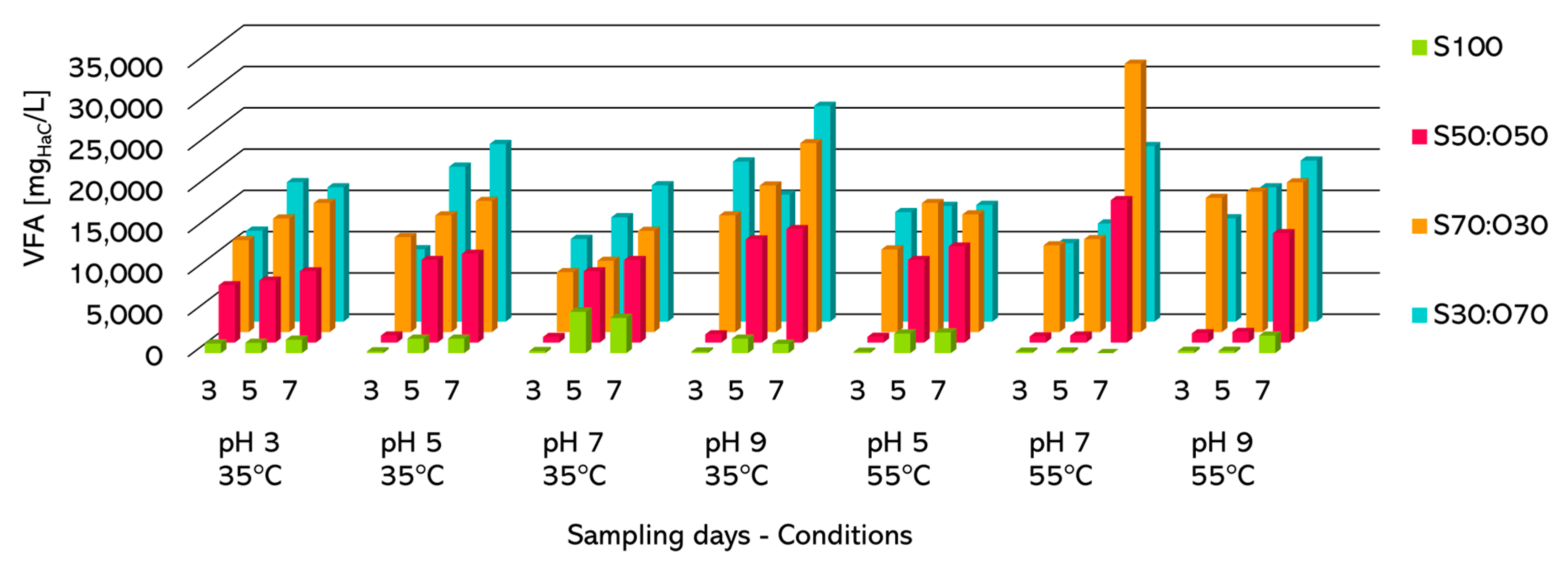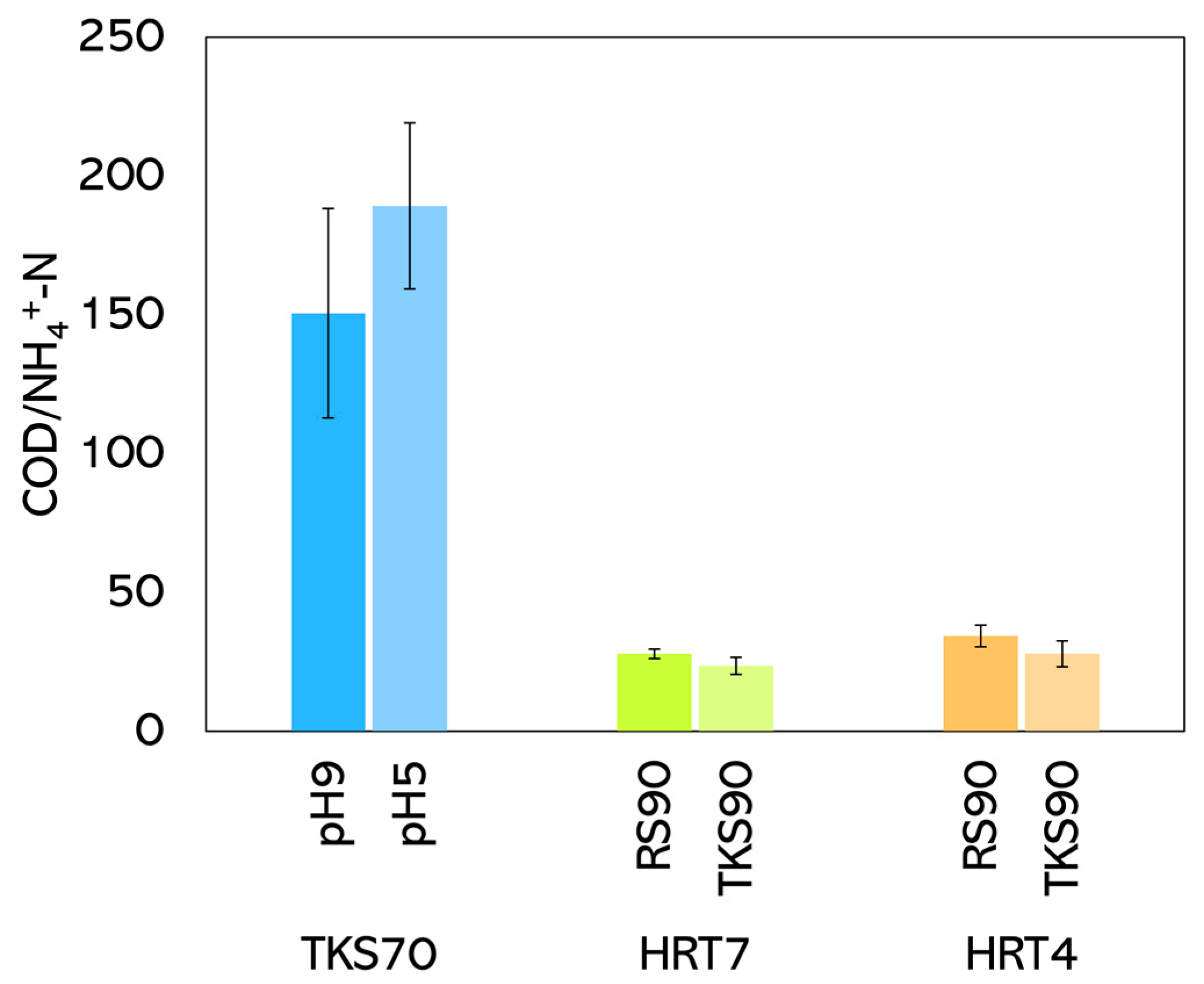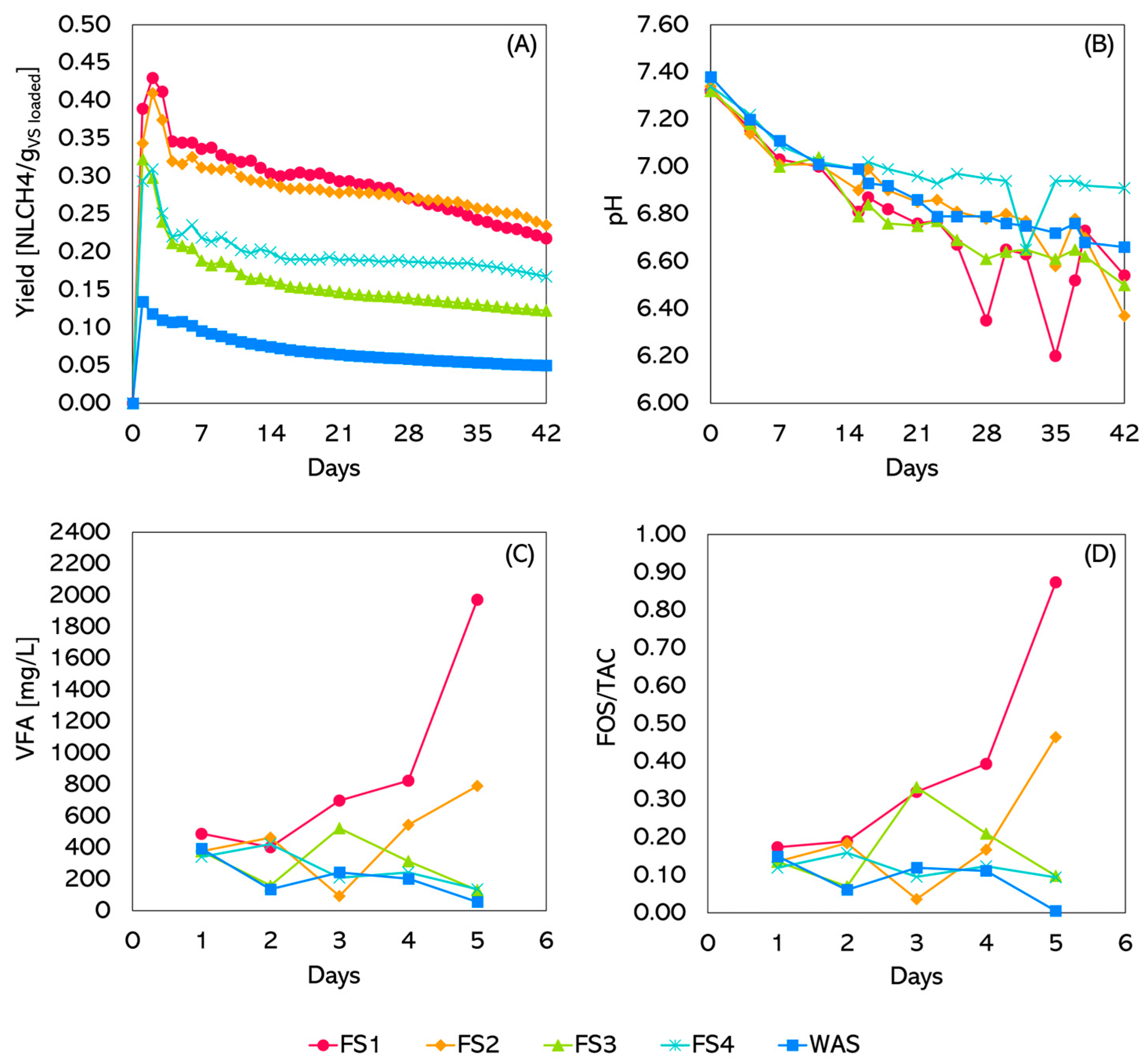Organic Waste and Wastewater Sludge to Volatile Fatty Acids and Biomethane: A Semi-Continuous Biorefinery Approach
Abstract
1. Introduction
2. Results
2.1. Batch Tests
Batch Test: Statistical Analysis
2.2. Semi-Continuous Tests
2.3. AD Semi-Continuous Tests
3. Discussion
3.1. Batch Tests
3.2. Semi-Continuous Tests
3.3. AD Semi-Continuous Tests
4. Materials and Methods
4.1. Substrates for Fermentation Experiments
4.2. Co-Fermentation Experiments Set-Up: Batch Tests
4.3. Co-Fermentation Experiments Set-Up: Semicontinuous Test
4.4. Analytical Procedures
4.5. Substrates for Semi-Continuous AD Test
4.6. AD Semi-Continuous Tests: Experiment Set-Up
4.7. Statistical Analysis
5. Conclusions
Supplementary Materials
Author Contributions
Funding
Data Availability Statement
Acknowledgments
Conflicts of Interest
References
- Vázquez-Fernández, A.; Suárez-Ojeda, M.E.; Carrera, J. Review about Bioproduction of Volatile Fatty Acids from Wastes and Wastewaters: Influence of Operating Conditions and Organic Composition of the Substrate. J. Environ. Chem. Eng. 2022, 10, 107917. [Google Scholar] [CrossRef]
- Atasoy, M.; Owusu-Agyeman, I.; Plaza, E.; Cetecioglu, Z. Bio-Based Volatile Fatty Acid Production and Recovery from Waste Streams: Current Status and Future Challenges. Bioresour. Technol. 2018, 268, 773–786. [Google Scholar] [CrossRef]
- Valentino, F.; Munarin, G.; Biasiolo, M.; Cavinato, C.; Bolzonella, D.; Pavan, P. Enhancing Volatile Fatty Acids (VFA) Production from Food Waste in a Two-Phases Pilot-Scale Anaerobic Digestion Process. J. Environ. Chem. Eng. 2021, 9, 106062. [Google Scholar] [CrossRef]
- Lee, W.S.; Chua, A.S.M.; Yeoh, H.K.; Ngoh, G.C. A Review of the Production and Applications of Waste-Derived Volatile Fatty Acids. Chem. Eng. J. 2014, 235, 83–99. [Google Scholar] [CrossRef]
- Agnihotri, S.; Yin, D.-M.; Mahboubi, A.; Sapmaz, T.; Varjani, S.; Qiao, W.; Koseoglu-Imer, D.Y.; Taherzadeh, M.J. A Glimpse of the World of Volatile Fatty Acids Production and Application: A Review. Bioengineered 2022, 13, 1249–1275. [Google Scholar] [CrossRef]
- Dai, K.; Wen, J.-L.; Zhang, F.; Zeng, R.J. Valuable Biochemical Production in Mixed Culture Fermentation: Fundamentals and Process Coupling. Appl. Microbiol. Biotechnol. 2017, 101, 6575–6586. [Google Scholar] [CrossRef]
- Chen, Y.; Luo, J.; Yan, Y.; Feng, L. Enhanced Production of Short-Chain Fatty Acid by Co-Fermentation of Waste Activated Sludge and Kitchen Waste under Alkaline Conditions and Its Application to Microbial Fuel Cells. Appl. Energy 2013, 102, 1197–1204. [Google Scholar] [CrossRef]
- Jiang, J.; Zhang, Y.; Li, K.; Wang, Q.; Gong, C.; Li, M. Volatile Fatty Acids Production from Food Waste: Effects of pH, Temperature, and Organic Loading Rate. Bioresour. Technol. 2013, 143, 525–530. [Google Scholar] [CrossRef]
- Fang, W.; Zhang, X.; Zhang, P.; Wan, J.; Guo, H.; Ghasimi, D.S.; Morera, X.C.; Zhang, T. Overview of Key Operation Factors and Strategies for Improving Fermentative Volatile Fatty Acid Production and Product Regulation from Sewage Sludge. J. Environ. Sci. 2020, 87, 93–111. [Google Scholar] [CrossRef]
- Peces, M.; Pozo, G.; Koch, K.; Dosta, J.; Astals, S. Exploring the Potential of Co-Fermenting Sewage Sludge and Lipids in a Resource Recovery Scenario. Bioresour. Technol. 2020, 300, 122561. [Google Scholar] [CrossRef]
- Wu, Q.-L.; Guo, W.-Q.; Zheng, H.-S.; Luo, H.-C.; Feng, X.-C.; Yin, R.-L.; Ren, N.-Q. Enhancement of Volatile Fatty Acid Production by Co-Fermentation of Food Waste and Excess Sludge without pH Control: The Mechanism and Microbial Community Analyses. Bioresour. Technol. 2016, 216, 653–660. [Google Scholar] [CrossRef] [PubMed]
- Pangallo, D.; Gelsomino, A.; Fazzino, F.; Pedullà, A.; Calabrò, P.S. The Fate of Biodegradable Plastic during the Anaerobic Co-Digestion of Excess Sludge and Organic Fraction of Municipal Solid Waste. Waste Manag. 2023, 168, 98–106. [Google Scholar] [CrossRef]
- Pangallo, D.; Pedullà, A.; Zema, D.A.; Calabrò, P.S. Influence of the Preliminary Storage on Methane Yield of Anaerobic Digestion of the Organic Fraction of Municipal Solid Waste. Processes 2021, 9, 2017. [Google Scholar] [CrossRef]
- Perez-Esteban, N.; Vinardell, S.; Vidal-Antich, C.; Peña-Picola, S.; Chimenos, J.M.; Peces, M.; Dosta, J.; Astals, S. Potential of Anaerobic Co-Fermentation in Wastewater Treatments Plants: A Review. Sci. Total Environ. 2022, 813, 152498. [Google Scholar] [CrossRef] [PubMed]
- Zhang, H.; Jiang, J.; Li, M.; Yan, F.; Gong, C.; Wang, Q. Biological Nitrate Removal Using a Food Waste-Derived Carbon Source in Synthetic Wastewater and Real Sewage. J. Environ. Manag. 2016, 166, 407–413. [Google Scholar] [CrossRef]
- Elefsiniotis, P.; Li, D. The Effect of Temperature and Carbon Source on Denitrification Using Volatile Fatty Acids. Biochem. Eng. J. 2006, 28, 148–155. [Google Scholar] [CrossRef]
- Liu, H.; Han, P.; Liu, H.; Zhou, G.; Fu, B.; Zheng, Z. Full-Scale Production of VFAs from Sewage Sludge by Anaerobic Alkaline Fermentation to Improve Biological Nutrients Removal in Domestic Wastewater. Bioresour. Technol. 2018, 260, 105–114. [Google Scholar] [CrossRef]
- Owusu-Agyeman, I.; Plaza, E.; Cetecioglu, Z. Production of Volatile Fatty Acids through Co-Digestion of Sewage Sludge and External Organic Waste: Effect of Substrate Proportions and Long-Term Operation. Waste Manag. 2020, 112, 30–39. [Google Scholar] [CrossRef]
- Satira, A.; Paone, E.; Bressi, V.; Iannazzo, D.; Marra, F.; Calabrò, P.S.; Mauriello, F.; Espro, C. Hydrothermal Carbonization as Sustainable Process for the Complete Upgrading of Orange Peel Waste into Value-Added Chemicals and Bio-Carbon Materials. Appl. Sci. 2021, 11, 10983. [Google Scholar] [CrossRef]
- Fazzino, F.; Pedullà, A.; Calabrò, P.S. Boosting the Circularity of Waste Management: Pretreated Mature Landfill Leachate Enhances the Anaerobic Digestion of Market Waste. Biofuel Res. J. 2023, 10, 1764–1773. [Google Scholar] [CrossRef]
- Cerdán, J.M.A.; Tejido-Nuñez, Y.; Aymerich, E.; de GoñiGoñi, J.G.-M.; Garcia-Aguirre, J. A Comprehensive Comparison of Methane and Bio-Based Volatile Fatty Acids Production from Urban and Agro-Industrial Sources. Waste Biomass Valorization 2021, 12, 1357–1369. [Google Scholar] [CrossRef]
- Ma, H.; Liu, H.; Zhang, L.; Yang, M.; Fu, B.; Liu, H. Novel Insight into the Relationship between Organic Substrate Composition and Volatile Fatty Acids Distribution in Acidogenic Co-Fermentation. Biotechnol. Biofuels 2017, 10, 137. [Google Scholar] [CrossRef] [PubMed]
- Moretto, G.; Valentino, F.; Pavan, P.; Majone, M.; Bolzonella, D. Optimization of Urban Waste Fermentation for Volatile Fatty Acids Production. Waste Manag. 2019, 92, 21–29. [Google Scholar] [CrossRef]
- Vidal-Antich, C.; Perez-Esteban, N.; Astals, S.; Peces, M.; Mata-Alvarez, J.; Dosta, J. Assessing the Potential of Waste Activated Sludge and Food Waste Co-Fermentation for Carboxylic Acids Production. Sci. Total Environ. 2021, 757, 143763. [Google Scholar] [CrossRef] [PubMed]
- Moretto, G.; Russo, I.; Bolzonella, D.; Pavan, P.; Majone, M.; Valentino, F. An Urban Biorefinery for Food Waste and Biological Sludge Conversion into Polyhydroxyalkanoates and Biogas. Water Res. 2020, 170, 115371. [Google Scholar] [CrossRef]
- Bengtsson, S.; Karlsson, A.; Alexandersson, T.; Quadri, L.; Hjort, M.; Johansson, P.; Morgan-Sagastume, F.; Anterrieu, S.; Arcos-Hernandez, M.; Karabegovic, L.; et al. A Process for Polyhydroxyalkanoate (PHA) Production from Municipal Wastewater Treatment with Biological Carbon and Nitrogen Removal Demonstrated at Pilot-Scale. New Biotechnol. 2017, 35, 42–53. [Google Scholar] [CrossRef]
- Mannina, G.; Presti, D.; Montiel-Jarillo, G.; Carrera, J.; Suárez-Ojeda, M.E. Recovery of Polyhydroxyalkanoates (PHAs) from Wastewater: A Review. Bioresour. Technol. 2020, 297, 122478. [Google Scholar] [CrossRef]
- Strazzera, G.; Battista, F.; Garcia, N.H.; Frison, N.; Bolzonella, D. Volatile Fatty Acids Production from Food Wastes for Biorefinery Platforms: A Review. J. Environ. Manag. 2018, 226, 278–288. [Google Scholar] [CrossRef]
- Batstone, D.J.; Keller, J.; Angelidaki, I.; Kalyuzhnyi, S.V.; Pavlostathis, S.G.; Rozzi, A.; Sanders, W.T.M.; Siegrist, H.; Vavilin, V.A. The IWA Anaerobic Digestion Model No 1 (ADM1). Water Sci. Technol. 2002, 45, 65–73. [Google Scholar] [CrossRef]
- Demirel, B.; Scherer, P. The Roles of Acetotrophic and Hydrogenotrophic Methanogens during Anaerobic Conversion of Biomass to Methane: A Review. Rev. Environ. Sci. Biotechnol. 2008, 7, 173–190. [Google Scholar] [CrossRef]
- Schink, B. Energetics of Syntrophic Cooperation in Methanogenic Degradation. Microbiol. Mol. Biol. Rev. 1997, 61, 262–280. [Google Scholar] [CrossRef]
- Stams, A.J.M.; Plugge, C.M. Electron Transfer in Syntrophic Communities of Anaerobic Bacteria and Archaea. Nat. Rev. Microbiol. 2009, 7, 568–577. [Google Scholar] [CrossRef]
- Feng, L.; Chen, Y.; Zheng, X. Enhancement of Waste Activated Sludge Protein Conversion and Volatile Fatty Acids Accumulation during Waste Activated Sludge Anaerobic Fermentation by Carbohydrate Substrate Addition: The Effect of pH. Environ. Sci. Technol. 2009, 43, 4373–4380. [Google Scholar] [CrossRef] [PubMed]
- Feng, L.; Yan, Y.; Chen, Y. Co-Fermentation of Waste Activated Sludge with Food Waste for Short-Chain Fatty Acids Production: Effect of pH at Ambient Temperature. Front. Environ. Sci. Eng. China 2011, 5, 623–632. [Google Scholar] [CrossRef]
- Garcia-Aguirre, J.; Esteban-Gutiérrez, M.; Irizar, I.; González-Mtnez de Goñi, J.; Aymerich, E. Continuous Acidogenic Fermentation: Narrowing the Gap between Laboratory Testing and Industrial Application. Bioresour. Technol. 2019, 282, 407–416. [Google Scholar] [CrossRef] [PubMed]
- Ma, S.; Hu, H.; Wang, J.; Liao, K.; Ma, H.; Ren, H. The Characterization of Dissolved Organic Matter in Alkaline Fermentation of Sewage Sludge with Different pH for Volatile Fatty Acids Production. Water Res. 2019, 164, 114924. [Google Scholar] [CrossRef]
- Romero-Güiza, M.S.; Vila, J.; Mata-Alvarez, J.; Chimenos, J.M.; Astals, S. The Role of Additives on Anaerobic Digestion: A Review. Renew. Sustain. Energy Rev. 2016, 58, 1486–1499. [Google Scholar] [CrossRef]
- Chen, H.; Meng, H.; Nie, Z.; Zhang, M. Polyhydroxyalkanoate Production from Fermented Volatile Fatty Acids: Effect of pH and Feeding Regimes. Bioresour. Technol. 2013, 128, 533–538. [Google Scholar] [CrossRef]
- Yang, X.; Liu, X.; Chen, S.; Liu, G.; Wu, S.; Wan, C. Volatile Fatty Acids Production from Codigestion of Food Waste and Sewage Sludge Based on β-Cyclodextrins and Alkaline Treatments. Archaea 2016, 2016, 1698163. [Google Scholar] [CrossRef]
- Gao, Y.; Peng, Y.; Zhang, J.; Wang, S.; Guo, J.; Ye, L. Biological Sludge Reduction and Enhanced Nutrient Removal in a Pilot-Scale System with 2-Step Sludge Alkaline Fermentation and A2O Process. Bioresour. Technol. 2011, 102, 4091–4097. [Google Scholar] [CrossRef]
- Long, H.; Latimer, R.; Khunjar, W.; Bilyk, K.; Bott, C.; Chiesa, S.; Balzer, B.; Nicholson, J.; DeArmond, J. FOG, Not Just for Co-Digestion: An Evaluation of Primary Sludge and Grease Trap Waste Fermentation for a Nutrient Removal Carbon Source. Proc. Water Environ. Fed. 2014, 2014, 799–807. [Google Scholar] [CrossRef]
- Jensen, T.R.; Lastra Milone, T.; Petersen, G.; Andersen, H.R. Accelerated Anaerobic Hydrolysis Rates under a Combination of Intermittent Aeration and Anaerobic Conditions. Water Sci. Technol. 2017, 75, 1944–1951. [Google Scholar] [CrossRef] [PubMed]
- Wang, D.; Tooker, N.B.; Srinivasan, V.; Li, G.; Fernandez, L.A.; Schauer, P.; Menniti, A.; Maher, C.; Bott, C.B.; Dombrowski, P.; et al. Side-Stream Enhanced Biological Phosphorus Removal (S2EBPR) Process Improves System Performance—A Full-Scale Comparative Study. Water Res. 2019, 167, 115109. [Google Scholar] [CrossRef]
- Tyagi, V.K.; Fdez-Güelfo, L.A.; Zhou, Y.; Álvarez-Gallego, C.J.; Garcia, L.I.R.; Ng, W.J. Anaerobic Co-Digestion of Organic Fraction of Municipal Solid Waste (OFMSW): Progress and Challenges. Renew. Sustain. Energy Rev. 2018, 93, 380–399. [Google Scholar] [CrossRef]
- Sosnowski, P.; Klepacz-Smolka, A.; Kaczorek, K.; Ledakowicz, S. Kinetic Investigations of Methane Co-Fermentation of Sewage Sludge and Organic Fraction of Municipal Solid Wastes. Bioresour. Technol. 2008, 99, 5731–5737. [Google Scholar] [CrossRef] [PubMed]
- Borowski, S. Co-Digestion of the Hydromechanically Separated Organic Fraction of Municipal Solid Waste with Sewage Sludge. J. Environ. Manag. 2015, 147, 87–94. [Google Scholar] [CrossRef]
- Ara, E.; Sartaj, M.; Kennedy, K. Enhanced Biogas Production by Anaerobic Co-Digestion from a Trinary Mix Substrate over a Binary Mix Substrate. Waste Manag. Res. 2015, 33, 578–587. [Google Scholar] [CrossRef]
- Bawiec, A.; Pawęska, K.; Jarząb, A. Changes in the Microbial Composition of Municipal Wastewater Treated in Biological Processes. J. Ecol. Eng. 2016, 17, 41–46. [Google Scholar] [CrossRef]
- Creamer, K.S.; Chen, Y.; Williams, C.M.; Cheng, J.J. Stable Thermophilic Anaerobic Digestion of Dissolved Air Flotation (DAF) Sludge by Co-Digestion with Swine Manure. Bioresour. Technol. 2010, 101, 3020–3024. [Google Scholar] [CrossRef]
- Borowski, S.; Boniecki, P.; Kubacki, P.; Czyżowska, A. Food Waste Co-Digestion with Slaughterhouse Waste and Sewage Sludge: Digestate Conditioning and Supernatant Quality. Waste Manag. 2018, 74, 158–167. [Google Scholar] [CrossRef]
- Calabrò, P.S.; Pangallo, D.; Zema, D.A. Wastewater Treatment in Lagoons: A Systematic Review and a Meta-Analysis. J. Environ. Manag. 2024, 359, 120974. [Google Scholar] [CrossRef] [PubMed]
- Directive-EU-2024/3019-EN-EUR-Lex. Available online: https://eur-lex.europa.eu/eli/dir/2024/3019/oj/eng (accessed on 7 June 2025).
- APHA; AWWA; WEF. Standard Methods for the Examination of Water and Wastewater, 22nd ed.; Rice, E.W., Baird, R.B., Eaton, A.D., Clesceri, L.S., Eds.; American Public Health Association, American Water Works Association, Water Environment Federatio: Washington, DC, USA, 2012; ISBN 978-0-87553-013-0. [Google Scholar]
- Baxter, T.E. Approximate Volatile Acids by Titration (Standard Operating Procedure AMBL-101-A); Northern Arizona University: Flagstaff, AZ, USA, 2014. [Google Scholar]
- DiLallo, R.; Albertson, O.E. Volatile Acids by Direct Titration. J. Water Pollut. Control Fed. 1961, 33, 356–365. [Google Scholar]
- Cavinato, C.; Bolzonella, D.; Pavan, P.; Fatone, F.; Cecchi, F. Mesophilic and Thermophilic Anaerobic Co-Digestion of Waste Activated Sludge and Source Sorted Biowaste in Pilot- and Full-Scale Reactors. Renew. Energy 2013, 55, 260–265. [Google Scholar] [CrossRef]
- Silvestre, G.; Bonmatí, A.; Fernández, B. Optimisation of Sewage Sludge Anaerobic Digestion through Co-Digestion with OFMSW: Effect of Collection System and Particle Size. Waste Manag. 2015, 43, 137–143. [Google Scholar] [CrossRef] [PubMed]





| OFMSW Batch Tests (Synthetic) | OFMSW Semi-Continuous (Real) | TKS Batch Tests | TKS Semi-Continuous | WAS Semi-Continuous | |
|---|---|---|---|---|---|
| TS [%] | 21.7 ± 0.56 | 31.4 ± 1.62 | 2.5 ± 0.13 | 3.2 ± 0.22 | 1.1 ± 0.02 |
| VS [%TS] | 96.2 ± 0.13 | 90.5 ± 0.50 | 74.8 ± 1.89 | 77.3 ± 0.38 | 76.9 ± 0.61 |
| pH | NA | 5.6 ± 0.02 | 6.5 ± 0.01 | 6.5 ± 0.02 | 7.0 ± 0.02 |
| Substrate | Co-Fermentation Test Source | TS [%] | VS [%TS] | pH |
|---|---|---|---|---|
| FS1 | 30:70 TKS:OFMSW pH 5 HRT 7d | 27.6 ± 0.87 | 77.5 ± 2.33 | 5.0 |
| FS2 | 30:70 TKS:OFMSW pH 9 HRT 7d | 26.5 ± 0.85 | 83.0 ± 4.80 | 4.8 |
| FS3 | 90:10 WAS:OFMSW HRT 7d | 10.9 ± 0.68 | 85.3 ± 0.96 | 5.0 |
| FS4 | 90:10 TKS:OFMSW HRT 7d | 12.5 ± 0.62 | 74.9 ± 4.41 | 5.2 |
| WAS | - | 1.4 ± 0.09 | 71.0 ± 1.98 | 6.7 |
| Inoculum | - | 5.6 ± 0.12 | 70.5 ± 0.85 | 7.7 |
Disclaimer/Publisher’s Note: The statements, opinions and data contained in all publications are solely those of the individual author(s) and contributor(s) and not of MDPI and/or the editor(s). MDPI and/or the editor(s) disclaim responsibility for any injury to people or property resulting from any ideas, methods, instructions or products referred to in the content. |
© 2025 by the authors. Licensee MDPI, Basel, Switzerland. This article is an open access article distributed under the terms and conditions of the Creative Commons Attribution (CC BY) license (https://creativecommons.org/licenses/by/4.0/).
Share and Cite
Calabrò, P.S.; Pangallo, D.; Ferreri, M.; Pedullà, A.; Zema, D.A. Organic Waste and Wastewater Sludge to Volatile Fatty Acids and Biomethane: A Semi-Continuous Biorefinery Approach. Recycling 2025, 10, 125. https://doi.org/10.3390/recycling10040125
Calabrò PS, Pangallo D, Ferreri M, Pedullà A, Zema DA. Organic Waste and Wastewater Sludge to Volatile Fatty Acids and Biomethane: A Semi-Continuous Biorefinery Approach. Recycling. 2025; 10(4):125. https://doi.org/10.3390/recycling10040125
Chicago/Turabian StyleCalabrò, Paolo S., Domenica Pangallo, Mariastella Ferreri, Altea Pedullà, and Demetrio A. Zema. 2025. "Organic Waste and Wastewater Sludge to Volatile Fatty Acids and Biomethane: A Semi-Continuous Biorefinery Approach" Recycling 10, no. 4: 125. https://doi.org/10.3390/recycling10040125
APA StyleCalabrò, P. S., Pangallo, D., Ferreri, M., Pedullà, A., & Zema, D. A. (2025). Organic Waste and Wastewater Sludge to Volatile Fatty Acids and Biomethane: A Semi-Continuous Biorefinery Approach. Recycling, 10(4), 125. https://doi.org/10.3390/recycling10040125








